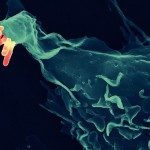Link to Pubmed [PMID] – 29250873
Cell. Microbiol. 2018 Apr;20(4)
Salmonella enterica induces membrane ruffling and genesis of macropinosomes during its interactions with epithelial cells. This is achieved through the type three secretion system-1, which first mediates bacterial attachment to host cells and then injects bacterial effector proteins to alter host behaviour. Next, Salmonella enters into the targeted cell within an early membrane-bound compartment that matures into a slow growing, replicative niche called the Salmonella Containing Vacuole (SCV). Alternatively, the pathogen disrupts the membrane of the early compartment and replicate at high rate in the cytosol. Here, we show that the in situ formed macropinosomes, which have been previously postulated to be relevant for the step of Salmonella entry, are key contributors for the formation of the mature intracellular niche of Salmonella. We first clarify the primary mode of type three secretion system-1 induced Salmonella entry into epithelial cells by combining classical fluorescent microscopy with cutting edge large volume electron microscopy. We observed that Salmonella, similarly to Shigella, enters epithelial cells inside tight vacuoles rather than in large macropinosomes. We next apply this technology to visualise rupturing Salmonella containing compartments, and we use extended time-lapse microscopy to establish early markers that define which Salmonella will eventually hyper replicate. We show that at later infection stages, SCVs harbouring replicating Salmonella have previously fused with the in situ formed macropinosomes. In contrast, such fusion events could not be observed for hyper-replicating Salmonella, suggesting that fusion of the Salmonella entry compartment with macropinosomes is the first committed step of SCV formation.
